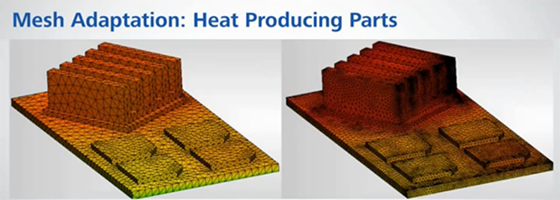As a relatively new addition to the Autodesk family of simulation products, Autodesk® Simulation CFD is attracting much attention. Autodesk is investing a lot of resources to make simulation accessible, easy to use, and most importantly, enhancing it to fit your workflow. Let’s take a look at some of the major enhancements to the Simulation CFD 2015 product.
Phase Change Simulation –
One of the most exciting changes in Simulation CFD is the introduction of phase change modeling. If your applications involve equipment like air conditioners, heat exchangers, or radiators, you will definitely find some benefits with this new capability. In the past, Simulation CFD could handle liquids or gasses such as humidity, steam, free surface models and some cavitation. With the new Simulation CFD 2015 we now have liquid-gas phase change simulation. This can account for the effect of boiling on both thermal and flow behavior. This is available for water, ammonia, R134A, and other refrigerants, plus your own custom blends.
Advanced Mesh Adaptation –
Mesh adaptation may not sound like something you would need, but does land on my list of important new features. Mesh adaptation has improved solution speeds and quality in almost all applications. Simulation CFD 2015 has added the following…
A) Free shear layers – As fluid or air passes around a bend in a segment of pipe the natural flow tends to migrate towards the outer bend of the pipe. As mesh adaptation detects this trend it refines the mesh in these areas to more accurately reflect the real flow patterns without tightening the mesh in the entire model. The image below shows the before and after mesh refinements.

B) Compressible shocks – traditional part meshing does not accurately capture a shock layer condition. In the image below, on the left, you can see the traditional mesh patterns. In the image below, on the right, you can see the effects of mesh adaptation which more accurately shows the shock curve without over-meshing the entire component.

C) Heat producing parts – As components introduce heat into a simulation model, mesh adaptation will refine these heat generating areas. This allows for a more accurate result without over-meshing the entire component system.

Spatially variable boundaries -
This particular enhancement was raised by the users on the Autodesk Simulation CFD IdeaStation. It’s nice to know Autodesk is listening to their users and generating results within the products.
Often, a user will need to specify a boundary condition with a gradient curve. This is useful in models where inlet conditions need to match physical measurements. Rather than specifying an inlet with a given velocity or flow you can now specify an inlet with a velocity profile. An example of this might be performing a wind study on a building. At ground level there might be a wind velocity of 10mph. At the top of the building the wind velocity might be 25mph. In previous releases you might split the input surface into multiple levels and set a velocity at each specific level. This would of course give varying results. With the Simulation CFD 2015 release you can now input a gradient curve to a single surface to achieve consistent results.
Customizable Report Generator –
This is another product enhancement driven by customer requests. Simulation CFD 2015 now has a fast, repeatable way of documenting simulation results. Reports are now customizable, sharable, printable, and repeatable. With a user friendly report options dialog you can choose and save exactly what you want to have, or not have, within your reports.
Heat Sink Model -
Simplified models can now be used in place of high mesh count models. Pre-calculated heat sinks are available to use and are easy to define. You simply assign the base surface, approach surface, and the material properties and you are ready to go. A typical heat sink can contain on average 1.6 million elements. A simplified version can reduce that count to 0.4 million elements. Heat Sinks currently represented are micro channel (extruded fin), pin fin (inline or staggered), offset strip, and manufacture tables.
Other -
Autodesk has also expanded the product import options to include STEP, CATIA, IGES, Rhino, Siemens JT as well as a new SpaceClaim CAD launcher and a revised Inventor Launcher. Cloud computing and remote solving is also now more robust and easier to use. And if you are using Simulation Mechanical, you can use your CFD pressure mapping directly within your Mechanical simulations.
Keep in mind these are only a few of the new features for Simulation CFD 2015. If you need any additional information about Simulation CFD 2015 or any of the other Autodesk Simulation products, please contact your Hagerman & Company, Inc. sales representative today!



Comments